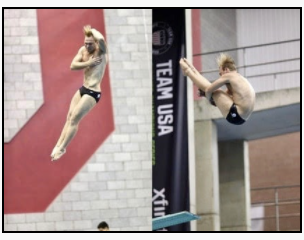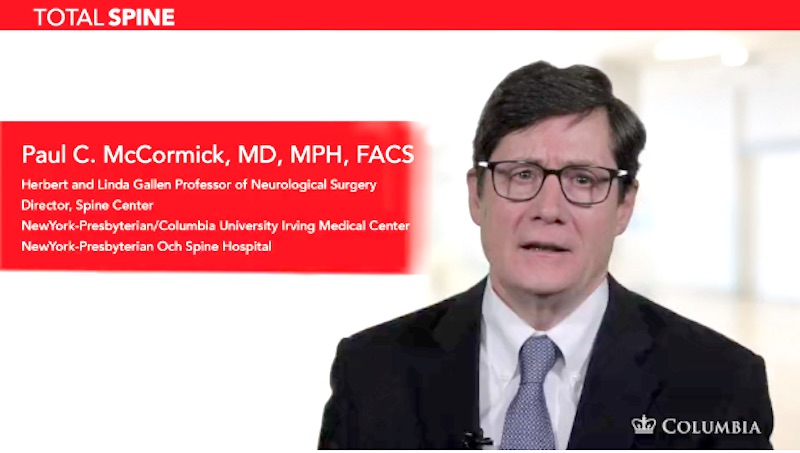California to New York: It’s a distance of about 3,000 miles. In May of 2016, high school sophomore Jake Greenberg and his parents made the round trip twice.
Jake’s symptoms had started in January, months before the family’s trips to New York City. The 16-year-old started experiencing back pain and swelling. As a diver who competed at regional and national levels, Jake first thought he had “tweaked” his back while training or diving. Then he began experiencing leg cramps. Soon, his hands were shaking—was this anxiety, or part of a set of neurological symptoms?
Jake’s family took him to the doctor. An MRI revealed what seemed to be a fluid-filled space called an arachnoid cyst low on Jake’s spine. Arachnoid cysts are caused by a buildup of fluid in the arachnoid—one of the protective layers around the spinal cord and brain. These cysts are often found in passing when doctors are investigating another problem, and they are generally left alone when they do not seem to be the cause of a patient’s symptoms. Jake’s arachnoid cyst was so low on his spine that it couldn’t explain the symptoms in his hands, and most doctors thought the cyst was not the source of any of his problems. But what was?
Jake took over-the-counter pain relievers to make it through the school day. The situation was far from ideal. He had back pain, swelling in his lower back, and cramps in his leg muscles. Diving, which had been a part of Jake’s life since the age of 8, was no longer possible.
If you’ve watched diving in the Olympics, you know that competitive divers propel themselves into the air, fall as a flurry of muscle and motion, then enter the water with hardly a splash. That graceful display depends on strength, flexibility, spinal mobility and skill. Jake couldn’t dive with his back and legs out of whack. He couldn’t even really work out to keep fit. His newfound inactivity and his worry about what was going on affected his schoolwork—and his psyche. “That was my worst year, academically. It was a stressful, depressing time,” he says.
Jake and his family visited doctor after doctor. The doctors gave a range of opinions: One thought the best option would be to install hardware in Jake’s spine, permanently limiting his spinal mobility. Another thought a different surgery would be appropriate, one that the surgeon gave about a 50-50 chance of relieving Jake’s symptoms. And another doctor said Jake’s MRI looked normal, there was no arachnoid cyst at all.
Then came a night in late April, about three months after Jake’s symptoms began. He was walking through his family’s house, and his right leg collapsed. “I started to freak out,” he says. “I was like, ‘What is going on?’ I had no function in my right leg at all, from the top of my leg to my toes.” That, says Jake, was when “the problem became urgent. The cramping wasn’t great, but I could deal with it. But the weakness in my legs, that was a total nightmare.”
The weakness ebbed and flowed, affecting one or both legs. “I could walk, but it was very difficult. I couldn’t really stand. I sat a lot,” he says.
Jake’s father redoubled his efforts to find help for his son. “My dad was basically a rock star. His whole life right around that time was researching who I should go to. He found Dr. McCormick and sent my case to him, and we flew out for a consult.” That was the first time they flew out to meet Dr. Paul McCormick, Director of the Spine Hospital at the Neurological Institute of New York.
When Jake and his parents, Alan and Sandra, met Dr. McCormick, they had a good feeling about him right away. “He immediately made us very comfortable. He explained his experience. He was just a very well-rounded guy, and confident in his abilities.”
Dr. McCormick suspected that Jake’s arachnoid cyst was compressing the cauda equina, the bundle of nerve roots at the base of the spine. The cauda equina is vital for movement and sensation from the waist down, and compression of this nerve bundle has the potential to cause serious and irreversible damage. Jake’s cauda equina wasn’t permanently damaged yet, but it would be better to have the surgery sooner rather than later.
Dr. McCormick explained the procedure he envisioned for Jake. He would remove a small part of two bones of Jake’s spine in order to access the spinal canal. Then he would open the dura mater—the tough, outermost protective layer that surrounds the brain, spinal cord and cauda equina. Opening the dura would expose the more delicate arachnoid layer, the layer with the cyst in it. Working carefully, Dr. McCormick would use an operating microscope and microsurgical tools to drain the cyst and remove as much of it as possible. This would clear some room for the nerve roots of the cauda equina.
The procedure would happen breathtakingly close to the pia—the innermost protective layer surrounding the spinal cord—and the nerve roots themselves. Dr. McCormick would employ constant monitoring of Jake’s spinal cord during the procedure. “Dr. McCormick basically was like, ‘I can do this,’ ” says Jake. The family was frightened at the prospect of such a serious surgery, but “we were really confident in him.”
Their confidence was well placed: Dr. McCormick is an internationally recognized expert in intradural spine surgery (surgery for which the dura must be opened).
Jake and his parents flew home to California so Jake could get back to school. Dr. McCormick rearranged his schedule, clearing the soonest possible spot for the surgery. And one week after that initial consultation, Jake and his parents came back for their second trip to New York—this time, for surgery.
The day of surgery, Jake and his parents were apprehensive. But at the hospital, “everyone was great. I mean, it started with blood work, and I’m scared of needles,” laughs Jake. “Though by the end of this,” he adds, “I had become very comfortable with needles.”
Jake was capable of walking, so he and the medical staff walked down to the OR together. “I sat down, and my legs started shaking, absolutely shaking, because I was terrified. But everyone was so great. The residents were being really nice, and the anesthesiologist was talking to me too—they were all being funny and calming me down.”
And that’s the last thing Jake remembers until waking up. The seven-hour surgery was over, and it had gone very well. The arachnoid cyst had been drained and its unusually thick walls removed. Now Jake faced recovery… and final exams.
The first two days after surgery, Jake had to lie flat in the hospital. The third day, he was allowed to sit up, and the fourth day, he walked. On the fifth day he was discharged. He and his family stayed in New York for several more days so that Jake could continue recovering under the care of Dr. McCormick and his medical team until Jake’s stitches came out. So Jake undertook the next part of his recovery in a hotel room, where he studied for his finals and gradually increased his physical activity.
During this time, Jake did have back pain from the surgery. But all his previous symptoms—the swelling, the leg cramps, even the weakness in his hands—had disappeared. On the tenth day after surgery, Jake got his stitches out at the hospital. Then he and his family flew home.
As soon as he got the ok from Dr. McCormick, Jake started physical therapy to get back in shape for diving. Twelve weeks after surgery, he slowly started diving again. He worked hard, and by the next summer, he says, “I was able to make it to nationals and finals!”
Today, he is at the University of Virginia—on a diving scholarship. “I’m hoping to qualify for Olympic trials in 2020 and make it to NCAA all four years in college,” says Jake.
Other goals? “I’d like to attend medical school and become a child and adolescent psychiatrist,” Jake says. “It’s a really big passion of mine.” His experience with his arachnoid cyst gave a specific direction to his long-standing interest in medicine. “That was a really rough time for me, and that’s a big reason I am interested in going into psych.”
In some ways, it sounds like Dr. McCormick is the type of doctor Jake would like someday to be. “He was really awesome and generous. I feel like a lot of doctors kind of just want to get through patients and get the appointment out of the way, on to the next one. But he really invests in you, I would say. He really cares for each individual’s wellbeing.”
“I really do feel like everything happens for a reason,” says Jake. “It sets you along your path to where you’re about to go.” And that’s the takeaway Jake would share with other patients in his situation. “I would say, just like everything, it shapes and molds you into who you are. Honestly, it was a really horrible experience… but it has made me a stronger person.
Thanks to Dr. McCormick, Jake has the opportunity to continue to grow stronger, both as a person and as an athlete—capable of pursuing ever-more-amazing feats of muscle and motion.
Learn more about Dr. McCormick on his bio page here.
In case you’re interested in learning more about Jake’s procedure, Dr. McCormick served as guest editor for the Journal of Neurological Surgery’s video atlas of intradural spine surgery (surgery like Jake’s, in which the dura must be opened). Read more about that work here.



